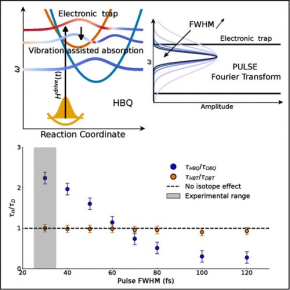When Quantum Coherence and Dissipation Alter Proton Transfer: A New Perspective on Excited-State Isotope Effects
Scientists have analyzed excited-state proton transfer (ESIPT) at the quantum scale by modeling two representative molecules, HBT and HBQ. Using an advanced numerical approach, the researchers reveal surprising isotope effects, including a possible inversion of these effects depending on the duration of laser pulses. The study highlights the previously underestimated influence of excitation conditions and the central role of molecular vibrations in these ultrafast processes.
References :
Impact and Interplay of Quantum Coherence and Dissipative Dynamics for Isotope Effects in Excited-State Intramolecular Proton Transfer, Brieuc Le Dé, Simon Huppert, Riccardo Spezia, Alex W. Chin, The Journal of Physical Chemistry Letters 16, 10, 2514–2521 - Published March 2, 2025.
DOI : 10.1021/acs.jpclett.4c03665

